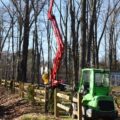We love our Montgomery and Bucks County trees just as much as we hate the leaf-eating insects that want to make a feast of them. It’s safe to say that when it comes to our yards, there’s nothing as discouraging as a beautiful tree or shrub that’s been reduced to a chewed-up ghost of its former self.
But with so many potential suspects, how do you know which insect is to blame?
In this article, you’ll learn about five different leaf-eating insect pests and how to identify the damage they cause. These include:
- Aphids (family Aphidoidea)
- Spider Mites (family Tetranychidae)
- Leaf Miners (family Cecidomyiidae)
- Spotted Lanternfly (Lycorma delicatula)
- Spongy Moth [formerly known as the Gypsy Moth] (Lymantria dispar)
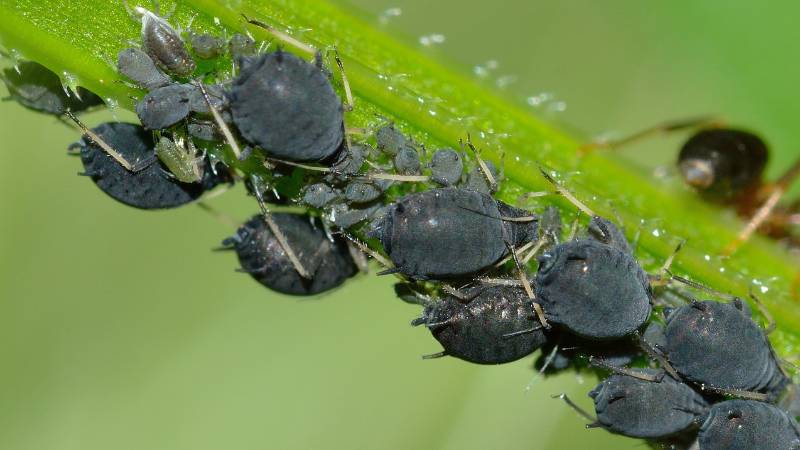
Leaf-Eating Insects
1. Aphids
Aphids are nasty little insect pests that attack plants in high numbers. While mainly a threat to your shrubs, aphids can hurt your trees if infestations are severe. Also called the plant louse or ant cow, these Pennsylvania pests use their piercing mouthparts to suck the juices from plant stems and leaves.
Identifying Aphid Damage
Plants attacked by aphids will show yellowing leaves and stunted shoot growth. In addition to the damage they cause, aphids are also identifiable by a sticky sweet substance they excrete called honeydew.
The honeydew attracts additional pests such as ants, scale insects, and mealybugs. Eventually, this honeydew will turn black as a fungal condition called sooty mold develops. While not particularly harmful to the plant, the sooty mold makes plants look dirty and unattractive.
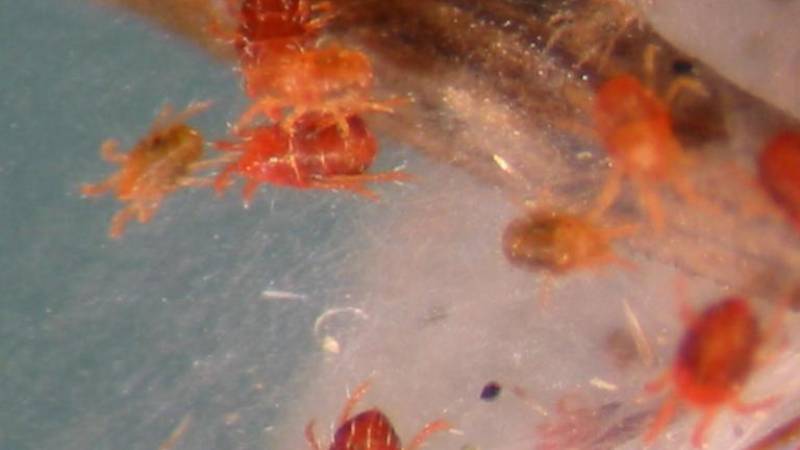
Spider mites are tiny pests that can be identified by the silk they secrete on the undersides of leaves. Photo used courtesy of Eric Coombs, Oregon Department of Agriculture, Bugwood.org.
2. Mites
Mites aren’t actually insects; they’re more closely related to spiders, but that doesn’t mean these pests are any less harmful to your plants. One common leaf-eating mite is the spider mite. These tiny pests are difficult to see with the naked eye and often require a magnifying glass to detect, but like aphids, they have piercing mouth parts they use to suck the juices from plants.
Identifying Mite Damage
The primary indicator of mite damage is the yellow or whitish spotting to the top side of your plant’s leaves where they feed. Additionally, you can confirm the presence of mites by examining the undersides of affective leaves for tiny eggs and the distinctive webbing secreted by spider mites. Mites are a major agricultural pest, but they can damage your suburban plants and fruit trees equally.
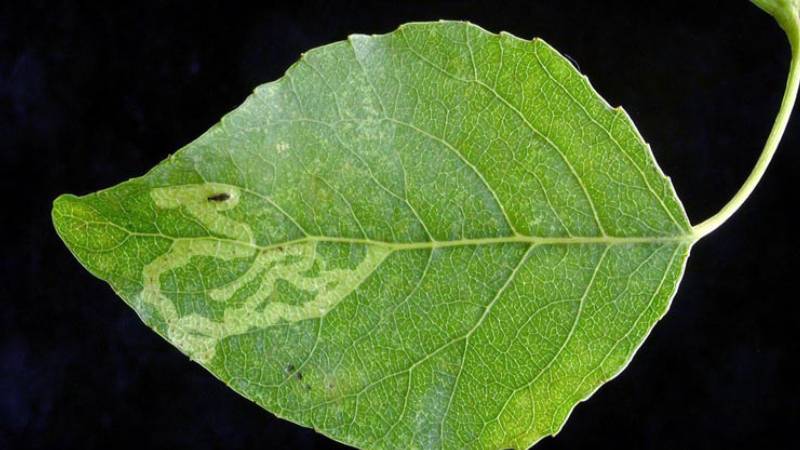
Leaf miner larvae feed between the layers of leaves, creating distinct squiggly tunneling patterns. Photo used courtesy of Gyorgy Csoka, Hungary Forest Research Institute, Bugwood.org.
3. Leaf Miners
Leaf miners are insect pests that feed on leaves from the outside and the inside. Female leaf miners use their mouthparts to feed by piercing plant tissue and sucking the juices from the inside. Leaf miner species can attack a variety of plants, but a few of the most affected Pennsylvania species are the boxwood, the holly shrub, and the black locust tree.
Identifying Leaf Miner Damage
When it’s time to reproduce, the females lay their eggs on the plants, and within 2-4 days, their larvae hatch and burrow into the leaf, mining tunnels between the leaf layers as they feed.
Leaf miner damage is relatively easy to spot. It appears as squiggly lines just below the surface of the leaves. These trails mined between the leaf layers are translucent with slightly white to yellow coloring.
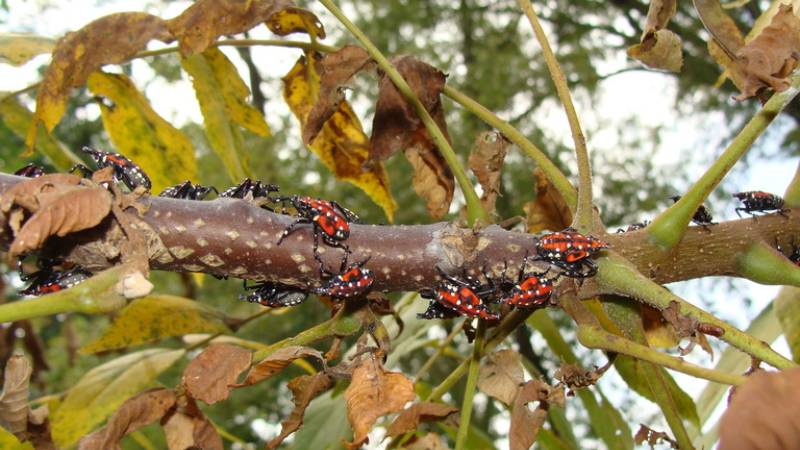
Spotted lantern flies feed in large numbers, using their piercing mouthparts to suck juices from trees and plants. Photo used courtesy of Eric R. Day, Virginia Polytechnic Institute and State University, Bugwood.org.
4. Spotted Lanternfly
The spotted lanternfly (SLF) is a significant pest throughout Pennsylvania and other states in the Northeastern US. This invasive plant hopper is such a threat to our trees that Pennsylvania has issued an SLF reporting system in addition to implementing county quarantines. Additionally, Middletown in Bucks County has stepped in with some tips on dealing with SLF locally.
These leaf-eating insect pests attack in high numbers and feed on 70 types of Pennsylvania plants, including grapes, hops, walnut trees, and other hardwoods.
Identifying Spotted Lanternfly Damage
Like other leaf-eating insects, spotted lanternflies use their piercing mouthparts to suck fluids from the insides of plant tissues. Spotted lanternfly damage is seen as leaf wilting, leaf curling, and dieback in trees. Similar to aphids, they also secrete honeydew, attracting additional pests and inviting the fungal condition, sooty mold.
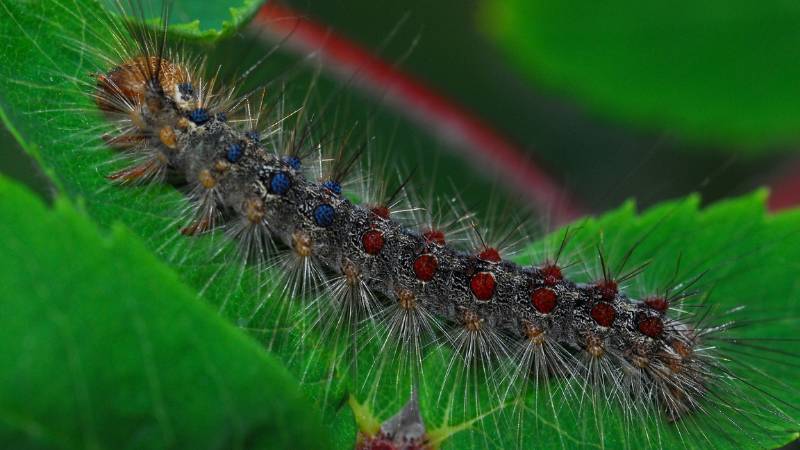
5. Spongy Moth (Gypsy Moth)
The spongy moth (formerly known as the Gypsy Moth) is a significant forest pest throughout Pennsylvania. Named for its sponge-like egg cases, the spongy moth caterpillar has been causing damage throughout Pennsylvania since the 1970s, but the state has experienced two significant outbreaks since then, one in 2013 and another in 2021. Though they prefer oak species, spongy moth caterpillars will feed on a variety of tree species, including:
- Apple
- Alder
- Aspens
- Basswood
- Birches
- Hawthorn
- Hemlock
- Tamarack (larch)
- Pines
- Spruces
- Willows
- Witch hazel
Identifying Spongy Moth Damage
Spongy moth caterpillars have voracious appetites, resulting in the defoliation of trees. This traumatic loss of foliage means the trees can’t perform photosynthesis, leaving them weak and vulnerable to disease. Defoliation by spongy moth caterpillars can completely kill a mature tree in one year.
Do You Need Help with Insect and Disease Management?
If you want to ensure your Pennsylvania trees and shrubs are safe from leaf-eating pests, call us at 215-542-8291 today! The pros at Clauser Tree Care are tree pest and disease experts who can assess your trees for any health issues in Bucks and Montgomery counties!

About Clauser Tree Care
From who you talk to on the phone in our office, to our courteous and experienced work crews who provide your service, all of the hard-working team members at Clauser Tree Care strive for complete client satisfaction. Our job is simply not done until you are pleased with the experience that you have had working with our company. Founded more than 25 years ago on the principles of honest work and arboricultural best practices, we strive for a higher standard of care for a greener future.



